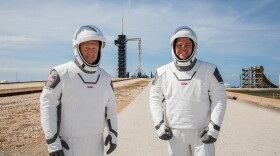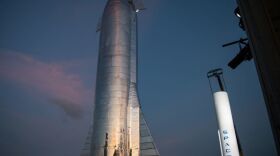There’s only one road to SpaceX — Texas Highway 4. It runs parallel to the Rio Grande, from Brownsville to Boca Chica Beach.
The 40-minute drive takes visitors past dense thickets of thorn scrub, the preferred habitat of endangered ocelots. The spiny vegetation eventually gives way to coastal flats, dunes and a peaceful beach, home to endangered sea turtles, as well as migratory birds not found elsewhere in Texas.
On a Tuesday in early September, a Cameron County sheriff's vehicle blocked off the road.
“The Highway’s closed until further notice,” a deputy told David Newstead, a program director with the nonprofit research and conservation group Coastal Bend Bays & Estuaries Program.
“Closed today?” Newstead asked.
“Yes, sir.”
The deputy was mistaken. After a brief back-and-forth about the nature of the closure — authorized by what’s known as “a temporary and intermittent closure order” — a voice came over his walkie-talkie.
“We are clear to open up the highway.”
The deputy moved his vehicle and let Newstead through. But other people, unaware of the esoteric closure rules that allow a private company to shut down a public road, had already headed back in the direction of Brownsville after being told the highway was closed.
SpaceX is allowed to completely close Boca Chica beach for 300 hours per year.
“That's when they're doing a launch or a test or something like that,” Newstead said.
But with the permission of Cameron County, the company can keep the beach technically open while closing Highway 4 — the sole access road. This type of closure doesn’t count toward the 300-hour annual limit, even though people can’t enter or exit the beach.
The 8-mile strip runs from just below South Padre Island down to the spot where the Rio Grande empties into the Gulf of Mexico. It’s popular with the majority-Latino, working-class population from Brownsville.
Newstead estimates the company has effectively closed the beach in excess of 1,000 hours per year.
The frequent closures complicate the type of research Newstead’s program does. The work often requires multiple surveys each week.
“That became impossible, essentially, starting last year,” he said.
Stephanie Bilodeau, a conservation biologist with the coastal bird program that Newstead leads, is the researcher trying to do those surveys.
“In areas where we previously had a dozen snowy plover, wilson plover nests in a season, close to where the launch pad is, it's slowly decreased over the years,” she said. “This year, we only had one nest in that area.”
The decline in nesting plovers has coincided with a dramatic increase in SpaceX operations.
Before SpaceX moved in, the Federal Aviation Administration conducted an “environmental impact statement,” an in-depth examination required by federal law. Since then, FAA regulators have allowed the company to ramp up activity beyond what was initially planned for.
“They incrementally just kept approving whatever it was that SpaceX continued to do,” Newstead said. “And that worked for five written reevaluations up to the point where you can see that the project bears no resemblance to what was originally proposed.”
Rather than doing new impact statements for the company’s increasingly large tests and launches, the FAA has done a series of “reevaluations” — a less intensive process.
The agency said SpaceX’s expanded operations haven’t been significant enough to warrant more scrutiny, although that could soon change. The FAA is currently reevaluating the impact of a possible Starship launch. If permitted, it would be the largest rocket to ever fly.
The agency’s boilerplate line in launch-related reevaluations reads: “Any potential accidental releases of hazardous materials would be managed according to SpaceX’s Hazardous Materials Emergency Response Plan. Accordingly, the data and analyses contained in the (environmental impact statement) remain substantially valid, and the Proposed Action would not result in a significant impact related to hazardous materials, solid waste, and pollution prevention.”
Put simply: SpaceX has a plan for any accidents. Therefore, accidents won’t have a significant impact.
In late March, SpaceX tested a large rocket — a prototype of the so-called “Starship.” It had been approved through the FAA’s less intense reevaluation process.
It exploded.
Rocket parts showered protected habitats overseen by the Texas Parks and Wildlife Department. SpaceX drove over the sensitive land with heavy machinery to retrieve the debris, which was scattered for miles. TPWD researchers were unable to access the area.
“It's fine Spacex," a TPWD biologist tweeted, and then deleted. "I'll just reschedule my field work until next year again because I can't drive down a state Highway or state beach. It's only public land and critical habitats you just showered with rocket parts.”
In internal communications obtained by TPR, a Texas Parks and Wildlife program leader wrote to the biologist, “It absolutely should not be this hard for us to get access to our own property. My impression is that they don't know what they are doing 4 days from now and want to keep all their options open which is completely unacceptable.”
The biologist said he had been asked to delete his tweet and noted that taxpayers bear the cost of the frequent closures.
“Yep but taxpayers can't access a public beach and refuge area,” the program leader responded.
60 Minutes+ has documented similar concerns from the U.S. Fish and Wildlife Service, which operates a national wildlife refuge in the area. The program obtained documents that described, "unauthorized encroachments and trespass on the refuge,” and photos that showed “SpaceX employees using refuge lands as a parking lot and, in another one, a drainage ditch on protected land.”
SpaceX declined TPR’s interview request and did not respond to written questions.
In a written statement, TPWD State Park Regional Director Reagan Faught said, “Texas Parks and Wildlife Department and SpaceX are working cooperatively on a multitude of issues that are of interest to both parties. Our adjacent lands and respective missions have at times produced a need to collaborate more closely, therefore we are continuing to work on refining measures that mitigate impacts to state park property and outdoor recreational use of the area. TPWD is committed to implementing strategies that will minimize or offset long-term impacts. The collective focus is on how our respective entities can better function and operate as neighboring property owners.”
State Highway 4 is now bustling with SpaceX equipment, employees, contractors and enthusiasts. The increased traffic has led to more roadkill — and hazardous conditions for drivers. The company is facing a $20 million lawsuit over the death of a 35-year-old man earlier this year. According to his family’s lawyers, Carlos Venegas crashed into a stalled 18-wheeler that was blocking the road at 4 a.m. while on the way back from the beach with his wife and children.
Before it became an industrial artery between the manufacturing facility and launch sites, the roadway was quiet, servicing public lands and a retirement community.
On her deck near Port Isabel, looking out over the Brownsville Ship Channel, South Bay and — in the distance — SpaceX, Maria Pointer spoke of her life in two chapters.
“We’re sitting in chapter two of Maria’s life,” she said, softly laughing. “We had a really nice life in the wilderness.”
That was chapter one. A house near Boca Chica Beach, toward the end of State Highway 4.
“And we thought no one would ever find us where we were at the end of the road,” she said.
Then SpaceX moved in.
The FAA’s initial environmental impact statement said area residents, like Pointer, wouldn’t experience too much disruption at night, aside from the occasional rocket launch.
“Significant impacts to community noise levels from proposed daily operations are not anticipated,” the statement read. “Noise impacts to up to 35 households in Boca Chica Village would be considered significant during a nighttime launch of the Falcon 9 and Falcon Heavy.”
But then operations ramped up. Pointer and her husband suffered from the 24/7 noise.
“It caused an immense amount of stress because of health issues for both of us … so we had a lot of grief,” she said.
Pointer and her husband sold the house to SpaceX.
“People were saying, ‘Gosh, Maria, you're supporting SpaceX, and they're taking your house, you know, what an idiot,’” she recalled. “They just didn't understand that after sleep deprivation, lights, noise, dust, choking dust, not just dust, but choking dust with grit and grime in the air, you could hear it hitting your house in the wind. Your trees and plants died.”
“You can't live in that situation. And you can't fight a billionaire.”
Now, chapter two: Pointer bought a new house just across the bay, with a view of the SpaceX launch site. She runs a YouTube channel devoted to all things SpaceX. StarshipBocaChica has more than 16,000 subscribers and millions of views. Despite the grief, Pointer is excited by Elon Musk’s grand vision of colonizing Mars.
“Yeah, I’m an Apollo kid from the '60s, and I was wanting to go back to the moon,” she said. “I’m right there with Elon, I’m ‘rah rah!’”
Not everyone feels the same. Cheryl Stevens sold her rental home to SpaceX. It was her primary source of income, and she planned to retire in it.
“I don't understand why people think that [Musk] is such a genius,” Stevens said. “I think, in my opinion, he’s a sociopath.”
In a 2019 letter, SpaceX told Boca Chica residents like Stevens that the company initially expected minimal disruption. But, the company said, the need to comply with FAA regulations and to continue expanding its operations would make that impossible.
“They're saying whatever they need to say to get things to go the way they want them to,” she said. “And in fact, that's what it's turned out to be — like, really a gigantic bait and switch.”
Further up the road in Brownsville, property prices have soared as Elon Musk has encouraged out-of-towners to move in. Local advocacy organization Fuera SpaceX has organized protesters and criticized local elected officials who helped pave the way for the company. Those officials often cite the economic benefits and employment opportunities that a company like SpaceX would ostensibly bring.
“Elon Musk has been inviting many people from around the country, from around the world, to come and take the jobs at SpaceX,” organizer Xandra Treviño said. “The people here — the lower income, middle income class people — they're not going to be involved in that. They were never meant to be involved in that. And this wealth divide is just going to grow.”
For SpaceX, the road to Mars is temporarily closed. The FAA is evaluating the environmental impact of what would be the largest rocket to ever fly.
The agency is seeking public comment on the project. Musk asked his 60 million Twitter followers to add their support.
“Humanity’s future on the moon, Mars & beyond depends upon it,” he wrote.
SpaceX appears confident about the outcome of the process. The company has already built a launch tower — without the approval of regulators — and has begun assembling the rocket in question — without a license to actually launch it.
Copyright 2021 Texas Public Radio. To see more, visit Texas Public Radio.

















